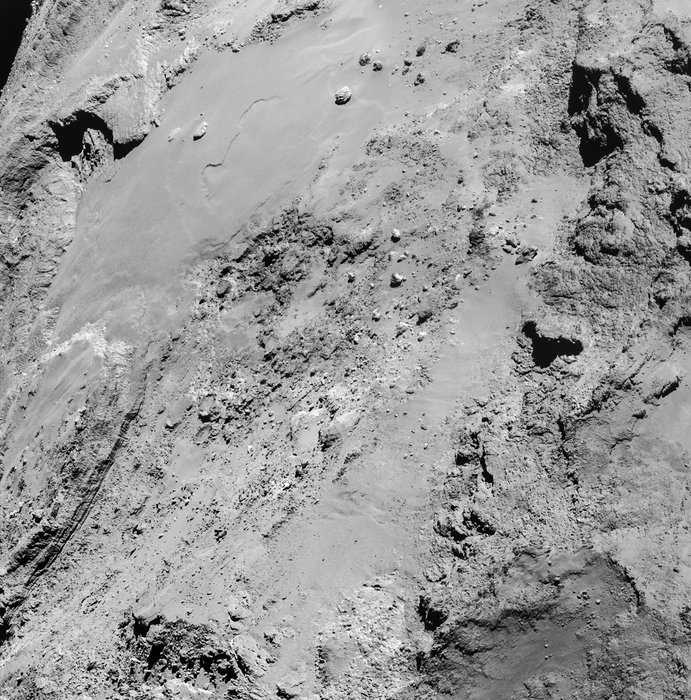On Saturday, Feb. 14, the Rosetta spacecraft swooped low over the surface of comet 67P/C-G in the first dedicated close pass of its mission, coming within a scant 6 km (3.7 miles) at 12:41 UTC. The image above is a mosaic of four
individual NavCam images
acquired just shortly afterwards, when Rosetta was about 8.9 km from the comet.
[caption id="attachment_118989" align="alignright" width="250"]
The 45m "Cheops" boulder on comet 67P/C-G (ESA/Rosetta/Navcam)[/caption]
The view above looks across much of the Imhotep region along the flat bottom of comet 67P's larger lobe. (See a map of 67P's named regions
here
.) At the top is the flat "plain" where the Cheops boulder cluster can be seen – the largest of which is 45 meters (148 feet) across.
Read more: Rosetta Gets a Peek at Comet 67P's Underside
The zero phase angle of sunlight during the pass made for fairly even illumination across the comet's surface.
The image scale on
the full mosaic
is 0.76 m/pixel and the entire view encompasses a 1.35 × 1.37 km-wide area.
Other NavCam images acquired before and after the pass have been assembled into mosaics – check those out below:
[caption id="attachment_118987" align="aligncenter" width="580"]
Four-image mosaic made from NavCam images acquired on Feb. 14, 2015 at a distance of 35 km. Credits: ESA/Rosetta/NavCam – CC BY-SA IGO 3.0.[/caption]
[caption id="attachment_118985" align="aligncenter" width="580"]
Four-image mosaic made from NavCam images acquired on Feb. 14, 2015 at a distance of 12.6 km. Credits: ESA/Rosetta/NavCam – CC BY-SA IGO 3.0.[/caption]
[caption id="attachment_118988" align="aligncenter" width="580"]
Four-image mosaic made from NavCam images acquired on Feb. 14, 2015 at 19:42 UTC at a distance of 31.6 km. Credits: ESA/Rosetta/NavCam – CC BY-SA IGO 3.0.[/caption]
In addition to NavCam images of 67P, Rosetta also acquired high-resolution OSIRIS images of the comet and gathered scientific data about its coma environment during the flyby. These data will be downlinked and processed over the next week or so.
Flybys will be regular parts of Rosetta's operations over the course of 2015, but due to the comet's increasing activity none will bring the spacecraft as close as this particular pass.
Rosetta is now moving out to a distance of about 250 km (155 miles) from 67P. Watch a video below of how the Feb. 14 flyby was planned and executed:
Source: ESA's Rosetta blog
(Also, on Feb. 9, Rosetta captured a
full-frame NavCam image
of 67P from 105 km. I've edited that image for additional contrast and added a blue tint. Enjoy!)
[caption id="attachment_118993" align="aligncenter" width="580"]
Comet 67P on Feb. 9, 2015 from 105 km (65 miles)[/caption]
 Universe Today
Universe Today
